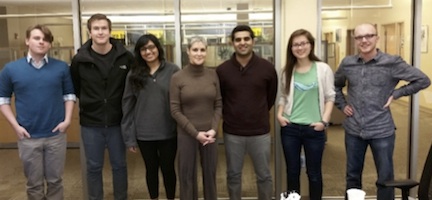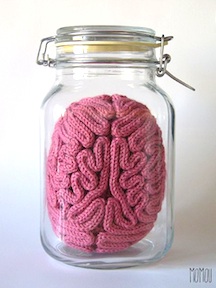By Nicholas McCarty
“How can we bring forth into public consciousness the aesthetic, poetic and beautiful dimensions that are inherent within math, science and engineering?” The question was directed to the crowded lecture hall. The sounds of feet tapping and heads scratching reverberated through the room.
This is just one of the questions that Margaret Wertheim posed to the University of Iowa community during her lecture “The Poetic Enchantments of Science.” Wertheim, an internationally-renowned science communicator, is known both for her 2009 TED Talk and her work in journalism. She has contributed articles to the New York Times, Los Angeles Times, Elle, Vogue and LA Weekly, for which she wrote the “Quark Soup” science column. During her guest lecture, Wertheim discussed topics ranging from the mathematics behind flower petals to the creation and utilization of yarn from recycled plastic bags. Today, Wertheim spends the majority of her time leading the Institute for Figuring (IFF), which she founded in 2003 with her sister, Christine.
The IFF was created with the goal of bolstering public science understanding through new methods of creative engagement and the concept of “material play.” Wertheim described it as the culmination of hybrid disciplines – a sort of “play tank” where people can build and visualize scientific ideas rather than merely thinking of them. It is a place where people can interact with science and learn that it is beautiful “not only for its answers, but also its methodologies,” she said.
The IFF is becoming increasingly known for its participatory programming, which engages worldwide communities in practices that have deep roots in both the creative arts and the natural sciences. One of the IFF’s predominant projects, called the Crochet Coral Reef, is a brilliant example of how natural scientists, mathematicians and handicraft workers can be brought together to produce something beautiful. The Crochet Coral Reef is, as its name suggests, a massive crochet replication of surviving coral reefs. The IFF recycles plastic bags to create yarn, which is then colored and incorporated into the final structures. Some of the faux coral reefs are more than ten feet tall. They have been exhibited in the Smithsonian (Washington, DC), GL Holtegaard (Copenhagen), The Hayward (London), and elsewhere. To date, the Crochet Coral Reef project has been displayed in over 35 countries and has been visited by hundreds of thousands of people.
Wertheim explained her purpose in developing the Crochet Coral Reef, stating:
“We live in a world where we…silo things. Physicists do this, mathematicians do this…on and on. Through [the Crochet Coral Reef Project], all of these disciplines come together to create a yarn….a narrative thread, that links things formerly thought of as quite distinct and far apart…together. Once we start teasing out the threads, we can find links between the smallest details and the biggest structures of all.”
The Crochet Coral Reef is a physical object with a purpose – it is building relationships between artists, scientists, and communities by focusing on the intersections of seemingly diverse disciplines. This ideology lies at the heart of the STEAM (Science, Technology, Engineering, Arts, and Math) movement: bring arts and sciences together to construct alluring designs and creative pieces with resonating societal or environmental statements.
As science continues to delve into the wonders of the natural world, society has been gaining an increased understanding of the mechanisms that make the earth, and life, tick. As these discoveries are made, it is imperative that the research is made accessible to a non-scientific audience. This has generated a tangible need for scientific communicators with the ability to disseminate information in an understandable, jargon-free manner.

Margaret Wertheim (center) meets with University of Iowa students to discuss scientific communication and the growing need for multidiscipline collaborations.
In January 2016, the National Science Foundation (NSF), which provides nearly $7 billion in research funding every year, revised their NSF Proposal & Award Policies & Procedures Guide. The new guide requires that grant applicants have a section of their proposals written in terms of their project’s “broader impact.” According to the NSF, this section of the proposal “should provide a discussion of the broader impacts of the proposed [research] activities…NSF values the advancement of scientific knowledge and activities that contribute to the achievement of societally relevant outcomes.”
Everybody has a vested interest in scientific research. We want to know how the latest scientific discovery or drug development could help our families or ourselves. We want to know about NASA’s latest findings because of the imagination that space exploration inspires. We want to know how the new factory down the road could impact our community’s health. There is an ever-present fascination with scientific discoveries, and scientists must learn to communicate and share their work in an accessible way. But they don’t have to do it alone – they can work with artists, engineers, or handiworkers to display their work visually. Researchers can collaborate with graphic designers to create web-based displays or coordinate with a museum to display their work in an exhibit. There are countless ways to share research and connect with those impacted by the work. It is just a matter of building new connections, playing with diverse ideas, and creating something beautiful.
Photo at top: Brain in a jar by Momu crochet.
Nicholas McCarty is a junior at the University of Iowa majoring in Biochemistry. The University of Iowa is home to the Alpha of Iowa Chapter of Phi Beta Kappa.




